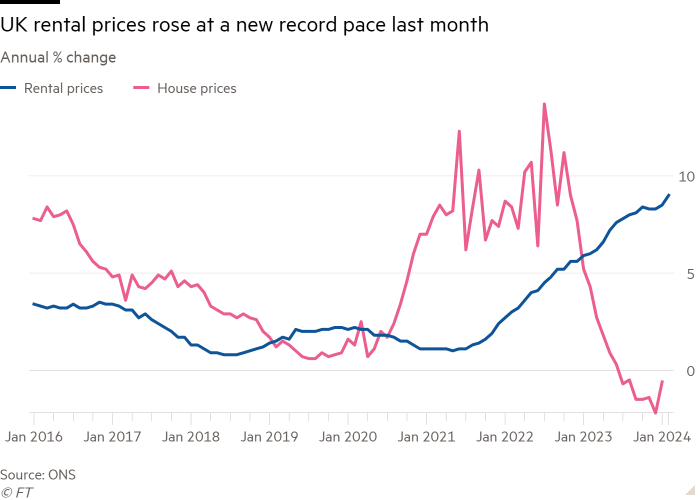Stay informed with free updates
Simply sign up to the UK property myFT Digest — delivered directly to your inbox.
UK rents rose by a record 9 per cent last month despite stagnant house prices, as higher borrowing costs squeezed both landlords and tenants.
The figures for February marked the biggest annual percentage change since the Office for National Statistics began collecting UK rent data in 2015. They compared with an 8.5 per cent rise for January.
Wednesday’s ONS statistics identified London as the English region with both the most expensive rent, at an average of over £2,000 a month, and the fastest rises, at 10.6 per cent a year.
The figures lag more commercial data provided by companies such as the property website Zoopla, which predicts that rent increases will outpace wages for the rest of the year.
But the 9 per cent rise highlighted how increased financing costs have hurt renters, because of landlords’ decisions to withdraw properties from the market or to pass on the cost of higher mortgage payments to their tenants.

Michelle Lawson, director at consultancy Lawson Financial, said landlords were also struggling with “huge tax bills and burdensome and costly regulation”, and that “tenants, some of whom are already financially on the edge, would suffer in the long run”.
The data showed the impact of more expensive mortgage deals on the property market, even though rates on offer have edged down in anticipation of rate cuts by the Bank of England later this year.
House prices declined 0.6 per cent in the year to January, although the market shows signs of stabilising, with a 0.5 per cent month-on-month increase since December.
The average house price was £281,913 compared with its August 2023 peak of £287,000.
There were large regional variations, with house prices rising at an annual rate of 4.8 per cent in Scotland but contracting 3.9 per cent in London.
The increase in the BoE’s benchmark rate to a 16-year high of 5.25 per cent has made it harder for many households to afford a home loan, so boosting rental demand.
The BoE’s monetary policy committee, which is due to meet on Thursday, is not expected to reduce rates before June, although lower rate expectations have already pushed down fixed-term deals.
Tax, mortgage and other costs have also contributed to a shortage of available properties.
The ONS reports prices across the entire stock of privately rented properties, a measure that lags prices for new-let agreements.
Other data has indicated that the rental market is now cooling, with estate agents surveyed in February forecasting rents will rise more slowly in the remainder of the year.
Hamptons said increases were starting to slow due to the more recent shift downward in mortgage rates but also because rents had become unaffordable for prospective tenants.
However, Aneisha Beveridge, Hamptons head of research, cautioned that “rents are still some way off falling annually and tenants continue to feel the squeeze”.
The ONS showed that the rental price growth eased from previous months in Scotland and Wales and remained largely stable in Northern Ireland. In contrast, it continued to accelerate in England.
The figures on Wednesday are the first to use more granular data, allowing the statistics agency to compare rental prices at a local authority level.
The ONS reported that the average private rent was highest in Kensington and Chelsea in central London at £3,248 and lowest in Dumfries and Galloway in Scotland at £472.
Excluding London, Bristol had the highest average private rent of £1,734 compared with an average in Great Britain of £1,238.












